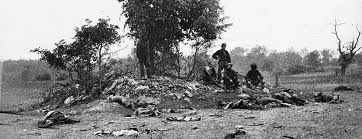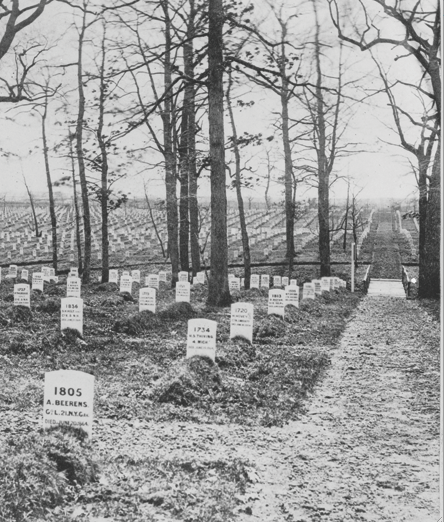Casualties Numbers And Battle Death Statistics For the American Civil War

Though the number of killed and wounded in the Civil War is not known precisely, most sources agree that the total number killed was between 640,000 and 700,000. (See article below)
Union Civil War Casualties
Combat Deaths: Over 110,000
Other Deaths*: Over 250,000
Confederate Civil War Casualties
Combat Deaths: Over 95,000
Other Deaths*: Over 165,000
(*Other Deaths include, among others: disease (by far the most common cause of death), accidents, drowning, heat stroke, suicide, murder, execution.)
Civil War Casualties: The Bloodiest Battles
Battle Of Gettysburg: Over 50,000 casualties
Seven Days Battle: Over 35,000 casualties
Battle Of Chickamauga: Over 34,000 casualties
Battle Of Chancellorsville: Over 29,000 casualties
Battle Of The Wilderness: Over 24,000 casualties
Battle Of Antietam: Over 22,000 casualties
Second Battle Of Bull Run: Over 24,000 casualties
Battle Of Shiloh: Over 23,000 casualties
Battle Of Fredericksburg: Over 18,000 casualties
Cold Harbor: Over 18,000 casualties
Articles Featuring Civil War Casualties From History Net Magazines
Featured Article
War by the numbers
By Harold Holzer
 Eyebrows were conspicuously raised recently when a “demographic historian” from New York’s State University at Binghamton convincingly recalibrated the long-accepted Civil War death toll—boosting the grisly statistic by an astounding 20 percent.
Eyebrows were conspicuously raised recently when a “demographic historian” from New York’s State University at Binghamton convincingly recalibrated the long-accepted Civil War death toll—boosting the grisly statistic by an astounding 20 percent.
According to Dr. J. David Hacker, the traditional death toll of 620,000—which historians have accepted for more than a century—failed properly to account for several key factors, including the influx of immigrants into the armed forces, not to mention casualties among black women who found themselves victims of the onrush of war. Hacker employed a new range of statistical accounting to determine mortality, including a system called the “two-census method.” To measure deaths, he counts the number of 20- to 30-year-olds in the 1860 census, and the number of 30- to 40-year-olds who turn up in—or, more important, disappear from—the next count, 10 years later. The difference represents the number of young people who died in the intervening decade, and Hacker took an educated stab, based on a shrewd reading of regional loyalties, at determining how many of them likely perished on the battlefield and not home peacefully in bed.
It’s useful to keep in mind that the long-accepted 620,000 tally was the work of two energetic but amateur historians, William F. Fox and Thomas Leonard Livermore, Union veterans who read every pension record, battlefield report and muster roll they could put their hands on. Fox published his Regimental Losses in the American Civil War in 1889—and through their extraordinary research we learned that the average Federal soldier weighed 143.5 pounds.
Inevitably, the new death-counting process proved more complicated than even this. For one thing, apparently, the reunited country’s 1870 census was something of a hash, with a level of undercounting that made the complaints around our recent 2010 census seem mild by comparison. Hacker admits it also remains difficult to count civilians who died in wartime. And he’s still as intrigued as the rest of us by the challenge of counting the number of farm boys who died from sickness after exposure to germ-riddled, but essentially immune, urban soldiers. Union medical care, he further points out, was far superior to Confederate—and more Johnny Rebs might have died of disease than Billy Yanks. Deaths among African-American troops have long had a widely accepted numerical accounting, but these numbers, too, Hacker believes, deserve reconfiguring, though no one is quite sure how to do it.
Caveats notwithstanding, Hacker bravely aimed at revising the total count, concluding the actual death toll for the Civil War amounted to between 650,000 and 850,000—and by prudently splitting the difference, proposed a new number: 750,000, as reported in America’s Civil War in March 2012. It also inspired a major New York Times story in April by Guy Gugliotta (whose new book, Freedom’s Cap, by the way, tells the extraordinary story of the U.S. Capitol and the coming of the rebellion). The scholarly journal Civil War History not only published the Hacker findings but trumpeted them, almost uncharacteristically, as “among the most consequential pieces ever to appear” between its covers.
Drew Gilpin Faust was right. In her extraordinary book This Republic of Suffering, the historian and president of Harvard University reminded modern readers of post-war America’s obsession with Civil War death and memory. The rush to build cemeteries, monuments and memorials, together with the overwhelming responsibility merely to bury dead bodies, filled survivors with an abiding reverence for, and obsessive fascination with, those who sacrificed that the nation might live (and even those who gave their lives that it might die). Exhumations were common as survivors and widows struggled with competing notions of sacred ground. Soldiers cemeteries became part of the American culture—and not just at Gettysburg. Those old emotions remain raw. Mass mourning is never far from the surface of American culture, and statistics not only encourage scholarly debate but expose unhealed wounds.
The new Civil War death toll numbers have stirred the pot afresh. In reporting the new statistics, the Times, for example, took an unexpected pot shot at veteran historian James M. McPherson, one among countless scholars who have long accepted the earlier 620,000 number. The article called out the dean of the field for using that number “without citing the source in Battle Cry of Freedom, his Pulitzer-winning 1988 history of the war.” The fact that no one else has ever “sourced” the figures did not seem to matter in the new rush to up the gruesome ante.
McPherson, in turn, had a bone to pick with yet another great historian, Mark E. Neely, who once convincingly argued that the Civil War was not a total war in the 20th-century sense. McPherson commented that the revised numbers suggest that Neely was wrong after all—for what else but a total war could produce such staggering casualty figures?
What is extraordinary about all this is that we still desperately want to know the truth—the whole truth, and nothing but the precise truth—about the toll of war. We may never find out for certain how many men and women, blacks and whites, native born and foreign born died to save the Union and destroy slavery. But as the new science and the new attention show—thanks to David Hacker, Guy Gugliotta, et al.—more than curiosity is at work here. Hacker put it modestly when he opined that “it is just a curiosity.” In a sobering afterthought, he wisely told Gugliotta and the Times: “It’s our duty to get it right.”
Harold Holzer is chairman of the Abraham Lincoln Bicentennial Foundation.
